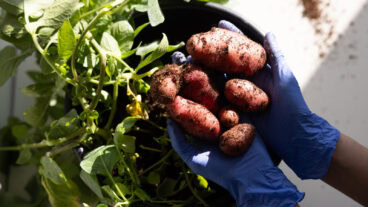Researchers have found that basil extracts methyl chavicol and linalool ooze out of the wrapping and slow the growth of eight types of lethal bacteria including E. coli and listeria. Shoppers confronted with the “paper or plastic” question in the supermarket checkout may soon also need to decide whether they want their perishables in plain or basil wrapping.
The basil is the same popular herb used to flavor foods. But in this case, the basil is incorporated into the plastic wrapping to preserve foods. The extracts methyl chavicol and linalool ooze out of the wrapping and slow the growth of eight types of lethal bacteria including E. coli and listeria.
“Our studies with storing cheddar cheese proved that the basil wrapping extended the shelf life of the cheese,” one of the product’s developers, Professor Joseph Miltz of the Technion-Israel Institute of Technology, told ISRAEL21c
Experiments also showed the wrapping most likely extends the shelf life of meats, fish, baked goods, fruits and vegetables.
Miltz, of the Faculty of Food Engineering and Biotechnology was the lead researcher of the packaging project which included Profs. K. Sonneveld, S. Bigger and doctoral student Panuwat Suppakul from the Victoria University of Technology in Melbourne, Australia. Their research was published in the Journal of Agricultural and Food Chemistry and presented at the annual symposium of the International Packaging Research Institutes in Valencia, Spain in May 2003.
Basil is an ideal packaging choice because it doesn’t impart its flavor to the foods since only small quantities of the extracts are needed. Also, because the active chemicals come from a natural source they don’t degrade into harmful byproducts, Miltz explains.
The researchers developed the idea of using basil in packaging when they read about research on adding basil to foods as a preservative.
Miltz knew that bacteria that cause spoilage are found on the food’s surface, so there was no reason to incorporate large quantities of the basil into the food. Instead, the researchers incorporated the basil extracts into the packaging in much lower concentrations. Later these extracts diffuse onto the surface of the food, killing the microorganisms.
“One of the biggest challenges is to find the right plastic composition to make the basil-containing wrap,” Miltz said. Production of plastic wrapping is carried out at high temperatures, which cause evaporation of the basil-extract molecules. Additionally, the wrap is permeable, which allows the basil extracts to escape to the outside atmosphere.
To counter this, the researchers are developing a multi-layered plastic with an impermeable outer layer and porous inner walls that will limit the flow of basil molecules to the inside of the package only. Marketing of the basil wrap will follow these improvements.
“We still need to optimize the system even though it’s been proven that it works, so we can’t estimate when the basil wrapping paper will be on the market,” said Miltz.
This is not the first time Miltz has worked on incorporating food preservative ingredients into packaging, a technology called “active packaging.” Since it is oxygen that promotes the growth of the microorganisms that create food spoilage, preventing oxygen from getting at packaged food has been a long-term goal. But oxygen cannot be completely removed from the package and also still leaks into it from outside.
Sachets (tea-bag like packages) containing oxygen absorbers are used in food packaging in Japan and to some extent in the Western world, “but consumers don’t like a package inside another package,” said Miltz. Additionally, when sachets with black iron powder were used as the oxygen absorber, some people thought the powder was pepper and spread it over the meat. The major concern stemming from this was that customers, especially children, may consume it by accident.
To overcome these shortcomings, in addition to the basil wrap, Miltz is working on making the oxygen absorption compounds an intrinsic part of the wrapper.












